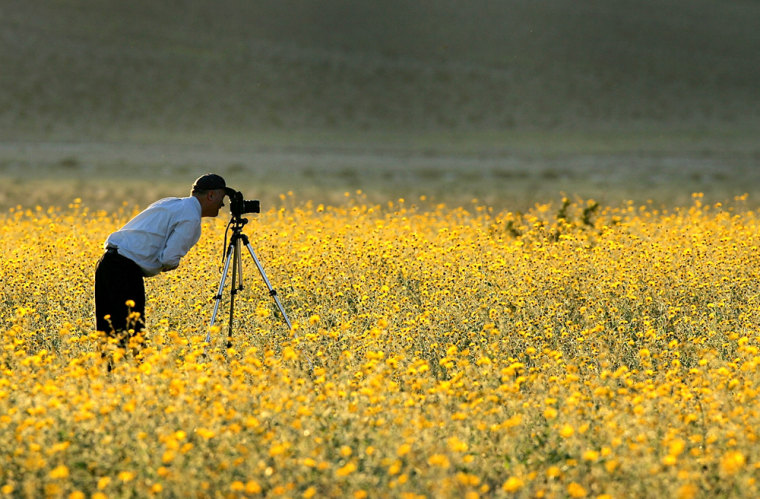A rare burst of color is softening the stark landscape of Death Valley, with clusters of purple, pink and white wildflowers dotting the black basalt mountainsides and great swaths of golden blooms bordering the blinding white salt flats on the valley floor.
The winter storms that brought mudslides and death to Southern California dropped 6 inches of rain on this thirsty desert — three times more than usual — encouraging wildflower seeds to sprout. Experts say this kind of show comes once in a lifetime.
The flowers have adapted to the desert by developing seeds with coatings so thick or waxy that they can hibernate for decades. Only continued heavy rains will coax them to grow. Then, when there's just the right amount of moisture, sunlight and warmth, "it's all systems go," says Pam Muick, executive director of the California Native Plant Society.
She says Death Valley hasn't seen such a wide array of flowers in about 50 years — blue pendants of desert lupine and tiny purple chias growing in clumps, golden California poppies scattering all over hillsides. Along roads leading into the park, long rows of bright yellow daisies wave, almost as if they'd been seeded to greet the visitors.
The normally forbidding landscape is not only alive with flowers, but fat, 3-inch-long green caterpillars that develop into Sphinx moths will come out soon to feast on the blooms, said Terry Baldino, a park ranger.
"They're the biggest, ugliest things you've ever seen," Baldino said. "And they have one thing on their mind — eating flowers."
The caterpillars and the abundance of new seeds will attract birds and small rodents, drawing in snakes and foxes in turn — a food chain that is very unusual for Death Valley, Baldino said.
Even in the early spring, temperatures are already soaring into the 90s, reminding tourists flocking in for the flower show that this is a place of extremes. A deep bowl about 156 miles long, the valley was created when great plates of earth pushed apart, giving rise to the Amargosa and the Panamint mountain ranges and dropping the valley floor 292 feet below sea level. The depression works like a convection oven, recirculating hot air and making the valley one of the hottest places on earth, with ground-level temperatures that can reach 200 degrees in summer.
It's also extremely dry, with less than 2 inches of rainfall a year. The water that does wash down the mineral-rich mountainsides carries salt deposits that have formed the great salt flats dominating the valley floor. Visitors can hike or drive for miles along the glistening salt pan, or examine the jagged salt formations that seem to mirror the snowcapped mountains looming in the background.
The recent storms have turned part of the salt pan around Badwater Basin — normally a brackish puddle a few inches deep — into a reflecting pool about five miles across. Kayakers and windsailers cut across the shallow, lifeless water. Other visitors wade in, only to emerge covered in a salt crust.
The flowers will continue to flourish until July, according to Baldino. The blooms in the southern reaches and lower elevations will fade within the next couple of weeks as temperatures climb, but the warmth will trigger seed banks farther north and higher up in the hillsides, creating a moving display.
These flowers will then drop seeds, which will lay dormant until the next really wet winter.
"This isn't a wasteland," Muick said. "It will start looking empty when the flowers are gone, but there's life there at all times."
